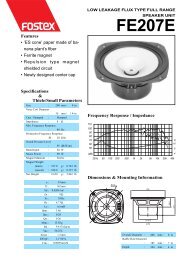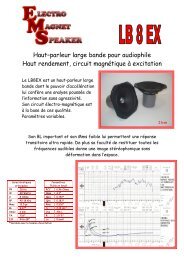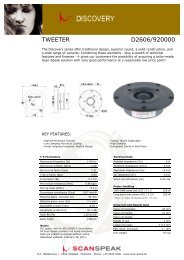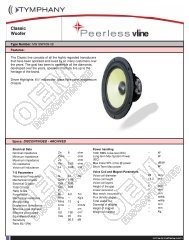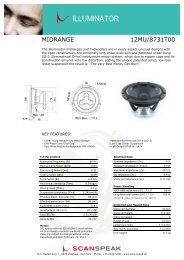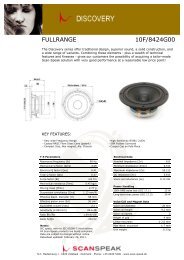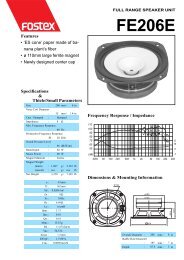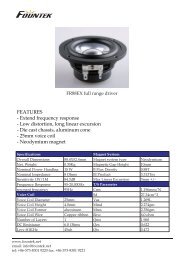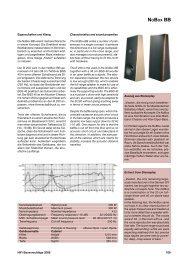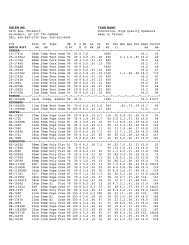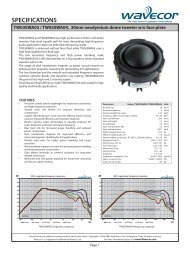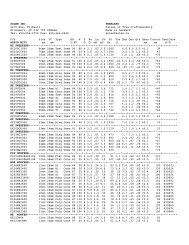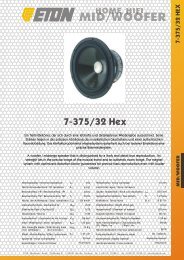Sie wollen auch ein ePaper? Erhöhen Sie die Reichweite Ihrer Titel.
YUMPU macht aus Druck-PDFs automatisch weboptimierte ePaper, die Google liebt.
General remarks<br />
The tables in each Group show which speakers are feasible for each channel. In general it can be said that all<br />
the combinations shown in the columns are possible. These proposals are not the only possible combinations,<br />
there are many others. The most important criterion to consider when putting together a set of speakers is the<br />
depth of colour of the sound produced. The system will only give hours of listening pleasure if the sound of each<br />
of the channels is matched to all the others. Similar sets of drivers in the mid- and high-range in all cabinets is<br />
the best precondition for holistic sound.<br />
Arranging centre loudspeakers<br />
Loudspeakers with twin drivers in the low- to mid-range, such as the COUPLET or ARIA 2, produce different radiation<br />
patterns along the longitudinal and lateral axes of the speaker. This is noticeable in a tighter bundling of<br />
the sound along the longitudinal axis. Where the drivers are positioned in the usual vertical arrangement (i.e. arranged<br />
vertically above one another), this produces the advantageous and desirable effect that less of the midrange<br />
sound is projected towards the floor and ceiling. A reduction in reflections from the ceiling and floor means<br />
less distortion of the direct sound reaching the listening position and better ability to locate the instruments in<br />
the stage layout.<br />
In multi-channel systems, the centre loudspeaker is often placed lying down. The result is that the effect described<br />
above is shifted to the horizontal plane. If one is not positioned directly in front of the centre speaker, a<br />
greater change in the sound depth is noticeable than with centre speakers placed upright. The further away from<br />
the centreline the listener is positioned, the more dramatic this effect becomes.<br />
We recommend, therefore, placing the centre speaker upright as long as the space allows.<br />
Even loudspeaker cabinets without twin drivers, such as the ARIA, should also be placed upright. Otherwise, the<br />
radiation pattern will not be symmetrical. The depth of colour of the sound changes to different degrees depending<br />
on whether one is seated to the left or right of the centre.<br />
A further key point to bear in mind when setting up loudspeakers is the height. The acoustic centre of the main<br />
speakers and the centre speaker should be at the same height. The ideal height is approximately the ear-height<br />
of the listener.<br />
Setting up dipoles<br />
Dipoles radiate the sound in two directions on different phases. The objective of this system is to generate a diffuse<br />
sound field through rear channels. However, this only works if the speakers are correctly set up: they have<br />
to be positioned exactly to the sides of the listening position and slightly above the ear.<br />
If this is not possible, because of the room layout, for example, it is preferable to use directly radiating speakers.<br />
For playing back multi-channel music, directly radiating speakers are recommended anyway for the rear channels.<br />
<strong>Sub</strong>woofer<br />
Most of our combined solutions recommend the use of a subwoofer. Sometimes, however, it is more sensible to<br />
include a second subwoofer. Larger rooms and high volume levels can make such high demands on the woofer<br />
that it has to be operated at the top end of its output range. This may result in greater distortion and less precise<br />
bass. A second subwoofer makes the system more efficient here.<br />
This also allows acoustic problems in the room to be overcome more effectively. If the bass range of frequencies<br />
is generated in a controlled manner at several points in the room, annoying resonance effects are reduced.<br />
If large, powerful main speakers are used, however, it is often not necessary to add an additional subwoofer. Two<br />
conditions have to be met to implement this concept:<br />
– the bass management system of the multi-channel decoder must allow the subwoofer channel to be switched<br />
off and all bass to be diverted to the main speakers. With many decoders this is the case.<br />
– the main speakers must have sufficient bass output to fill the listening room effectively.<br />
40 Surround Sound VISATON ®



